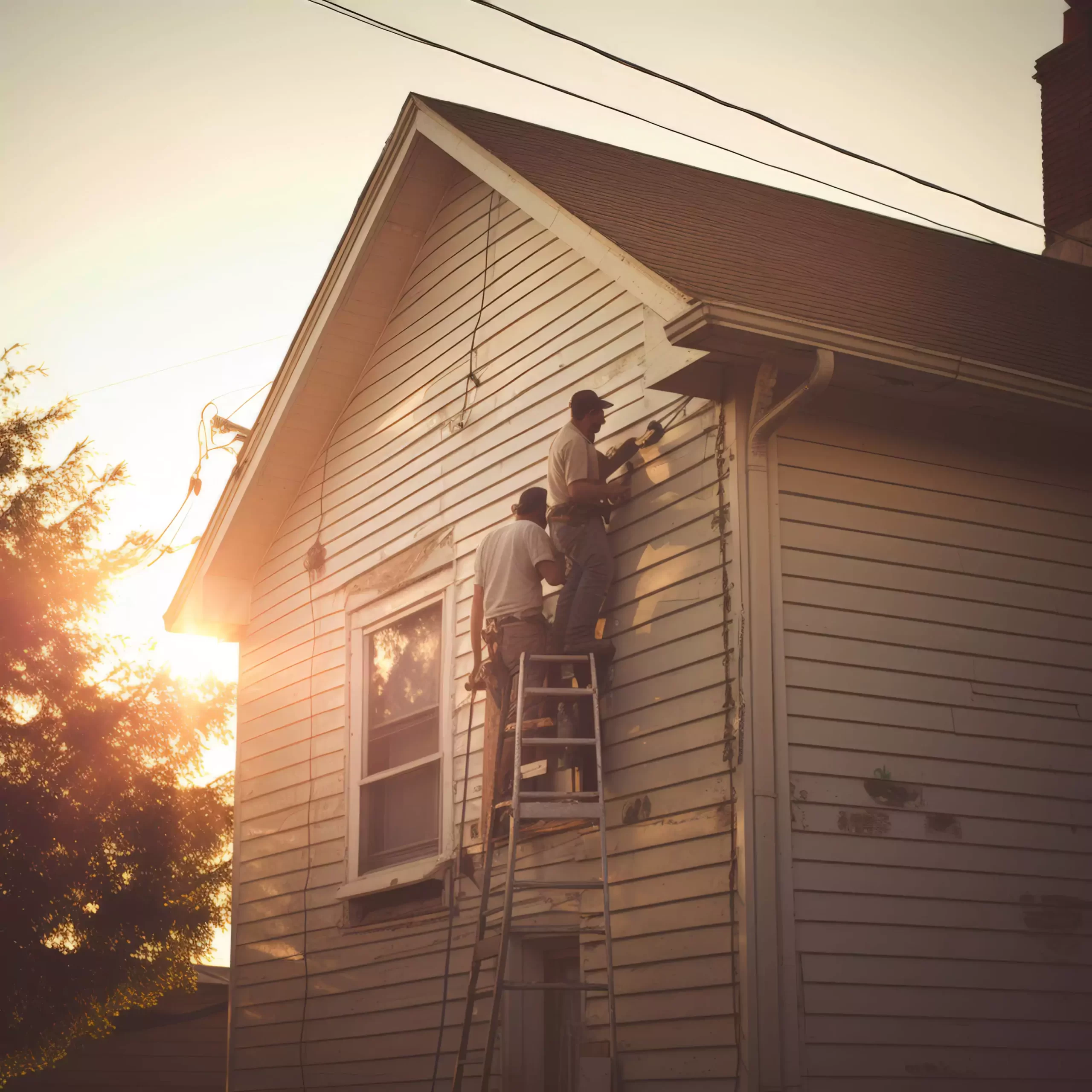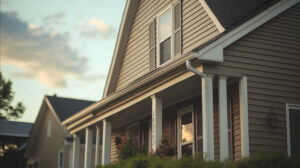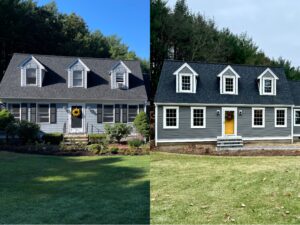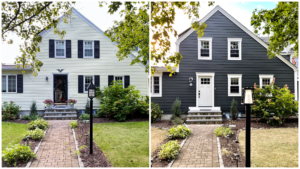

Project Manager at Plum ProExteriors
Understanding the Cost of Siding Replacement: A Comprehensive Guide for Homeowners

If it’s time to replace your home’s siding, this is an important investment for protecting your property and maintaining its value. Whether you’re dealing with damaged or outdated siding, analyzing the question,”How much does it cost to replace siding?” can help you avoid unexpected expenses.
Multiple aspects must be considered, from material selection and labor costs to regional price variations and potential hidden fees. This guide will demonstrate the various elements that influence the siding replacement cost. By exploring the financial aspects of siding replacement, you can better plan for a renovation that enhances your home’s appearance, structural integrity, and energy efficiency.
What is siding and why does it matter?
Siding, also known as cladding, is the protective material attached to a building’s exterior to shield it from the elements and provide an aesthetically pleasing appearance. Siding shields your home from weather like rain, wind, snow, and sun, keeping it strong and looking good. It comes in different materials, colors, and designs, so you can customize your home’s look while boosting durability and energy efficiency.
Below are the crucial advantages of siding installation:

Protection from the elements
Siding serves as the first shield against weather, guarding the structure from moisture, wind, and temperature changes. By blocking water, it helps prevent mold, mildew, and structural damage, keeping the home in good shape.
Improved curb appeal
With various materials, colors, and styles, siding offers plenty of options to improve a home’s exterior look. Whether you prefer a classic wood design or a sleek modern metal finish, siding lets homeowners achieve their desired style while boosting curb appeal.
Boosted energy efficiency
Modern siding, especially insulated types, adds extra insulation to help maintain indoor temperatures, reduce heat loss, and lower energy bills, making the home more comfortable and energy-efficient.
Minimal maintenance
Vinyl and fiber cement siding need less care compared to traditional wood siding. They resist fading, warping, and pests, cutting down on maintenance and repairs.
Long-lasting durability
High-quality siding is built to handle tough weather and offer reliable, long-term protection for your home. With proper installation and care, siding can last for decades, offering homeowners peace of mind.
Increased home value
Investing in new siding can significantly increase a home’s value by enhancing its appearance, energy efficiency, and structural protection. Potential buyers often view new siding as a desirable feature, making selling the property at a higher price easier.
Factors affecting siding replacement costs
Factors affecting siding replacement costs Several vital elements determine how much you’ll spend on a siding replacement project, from the type of material you choose to the specific characteristics of your home. We prepared an in-depth look at the primary elements affecting siding replacement costs:

1. Material type
The siding material you pick significantly affects the total cost. Each material varies in price, appearance, durability, and maintenance needs. Common options include vinyl, wood, fiber cement, stucco, and stone siding.
2. Home size and design
Your home’s size and architectural design are important in determining the siding replacement cost. Additionally, homes with complex designs, multiple stories, or unique architectural features may need more time and expertise to replace siding, increasing labor expenses. Features such as dormers, bay windows, and intricate trims can add complexity to the replacement process, impacting the overall cost.
3. Labor costs
Hiring skilled and reliable professionals is important, as poor installation can lead to future issues and added costs. Labor typically makes up 30% to 50% of the total project cost. Be sure to get multiple quotes from local contractors and check their credentials to ensure quality work at a fair price.
4. Removal and disposal of old siding
Before installing new siding, the old siding must be removed and disposed of. The cost depends on the type and condition of the old siding. For instance, removing and disposing of asbestos siding can be more expensive due to the need for specialized handling and disposal procedures. It is a great idea to discuss these siding costs with your contractor and include them in your overall budget.
5. Additional repairs and preparations
Additional repairs and preparations may be necessary during the siding replacement process to ensure a successful installation. This may involve fixing damaged sheathing, adding insulation, or resolving problems with the structure beneath. While these repairs can increase the overall house siding cost, they are necessary for the long-term performance and durability of the new siding. Let’s check these additional points below.
- Sheathing repairs: If the sheathing beneath the old siding is damaged or rotted, it must be repaired or replaced before installing the new siding.
- Insulation: Adding insulation when replacing siding can improve your home’s energy efficiency and comfort. It costs more initially, but the long-term energy savings can be worth it.
- Moisture barriers: Installing a moisture barrier like house wrap helps block water from seeping in and extends the lifespan of your siding. This additional step can increase costs but provides valuable protection against moisture-related damage.
Breakdown of siding materials and their costs
Each siding material offers unique benefits, aesthetic appeal, and costs, influencing your decision based on budget, maintenance preferences, and the architectural style of your home.
Let’s look at the most popular siding materials and their costs:
Vinyl siding

Vinyl siding is popular because it’s affordable, versatile, and low-maintenance. Made from PVC, it comes in many colors and styles, including ones that mimic wood.
- Low maintenance: Just clean with a hose and mild soap. Durability: Resists moisture, insects, and rot, making it suitable for various climates.
- Affordability: A cost-effective option, offering good value for the price.
- Siding cost: Typically ranges from $10 to $12 per square foot.
Wood siding

Wood siding gives a classic, timeless look with natural beauty that adds character to homes. Available in clapboard, shingles, and shakes, it can be made from cedar, redwood, pine, and more.
- Aesthetic appeal: Gives a warm, natural look that you can customize with stains or paint.
- Eco-friendly: A renewable resource, especially when sustainably sourced.
- Siding cost: Ranges from $26 to $32 per square foot.
Fiber cement siding

Made from cement, sand, and cellulose fibers, it looks like wood or stucco but is more durable.
- Durability: Long-lasting and low-maintenance.
- Versatility: Can resemble wood, stucco, or stone for different design styles.
- Siding cost: Ranges from $18 to $22 per square foot.
Stucco siding

Made from cement, sand, and lime, it’s commonly used on southwestern and Mediterranean-style homes. It has a smooth, seamless finish and can be textured and colored.
- Aesthetic appeal: Offers a unique, customizable look.
- Energy efficiency: Provides good insulation, helping to maintain comfortable indoor temperatures.
- Siding cost: Typically costs between $28 and $32 per square foot.
Stone siding

Both natural and manufactured stone siding provides a classic, elegant look. It’s very durable, low-maintenance, and often used for luxury homes.
- Durability: Resists fire, insects, and weather damage.
- Aesthetic appeal: Luxurious and sophisticated, significantly enhancing curb appeal.
- Siding cost: Natural stone costs $74-$76 per square foot, while manufactured stone veneer ranges between $38 to $42 per square foot.
Additional costs to consider
Of course, several additional house siding costs can impact the overall budget. These costs are essential to understand the total investment required comprehensively. Below is a breakdown of critical extra costs for your siding replacement project.
Permits and inspections
Before beginning a siding replacement project, it’s essential to check with local building authorities to determine if permits and inspections are required. These regulations are designed to ensure that the work meets safety and quality standards, but they can also add to the project’s overall siding cost.
Many local governments require a permit for siding replacement to ensure it meets building codes. Permit costs depend on your location and the size of the project. Getting the permit before starting is important to avoid fines or delays.
Sometimes, an inspection is also needed to confirm the siding is installed according to code. This could involve one or more inspections throughout the project. If you’re working with a contractor, these siding installation costs may be included in the overall project fee, but confirming this beforehand is essential.
Warranties and insurance
Warranties and insurance are key parts of a siding replacement, offering protection for both the homeowner and contractor. Understanding these costs helps ensure a smart investment.
Many siding manufacturers provide warranties that cover material defects and sometimes labor. Coverage can vary greatly in length and details. Basic warranties may last 5 to 10 years, while more comprehensive options can extend to 25 years. There may be additional siding costs for extended warranties or enhanced coverage.
Also, ensure the contractor has proper insurance, including liability and workers’ compensation, to cover any issues or damage during the project. Contractors should provide proof of insurance, and while this may not be a direct cost to you, it’s crucial for safeguarding your investment. Some contractors include insurance in their project siding prices, while others may not, so clarify this aspect during the bidding process.
Maintenance costs
Besides the initial investment in siding replacement, it’s essential to consider the ongoing maintenance costs associated with various siding materials. Regular maintenance is important for keeping your siding in good condition and can impact the overall cost of ownership.
- Routine upkeep: Most siding materials require routine upkeep to maintain appearance and functionality. This can include regular cleaning, inspections, and minor repairs to address issues such as dirt buildup, wear and tear, or minor damage. The amount and frequency of maintenance needed depends on the material and weather conditions.
- Repairs: Over time, your siding may develop issues that require repair. This can include fixing cracks, addressing damage from weather or pests, or replacing sections of siding. The cost to replace siding varies based on the damage and the complexity of the repair.
- Protective measures: Some siding materials benefit from additional protective measures, such as painting, sealing, or applying protective coatings. These measures can help extend the life of your siding and maintain its appearance but may involve additional costs over time.
Cost-saving tips for homeowners
Homeowners can employ some valuable strategies to manage siding costs without compromising on quality. Planning carefully and making informed decisions can reduce expenses while ensuring a successful siding replacement project. Here are some helpful tips to keep in mind:

1. Use off-season discounts
One effective way to save on siding replacement costs is to take advantage of off-season discounts. The demand for siding installation tends to be lower during the fall and winter months, as most homeowners prefer to undertake exterior renovations in the warmer seasons. During the off-season, contractors may offer discounts and promotions to keep their crews busy, allowing you to save money on labor and materials.
- Timing your project. Schedule your replacement project for late fall or winter, when contractors are more available and willing to negotiate siding prices.
- Talking to contractors about off-season discounts or upcoming deals. Being flexible with your schedule and choosing less busy times can help you save money.
2. Choose DIY or professional installation
While professional replacement ensures quality work and adherence to building codes, some homeowners with the necessary skills and experience may choose to handle certain aspects of the project independently.
First, assess how comfortable and skilled you are with home improvement tasks. Suppose you have prior experience with a siding replacement or a background in construction. In that case, you might be able to handle part of the work yourself, such as removing old siding or preparing the surface.
Also, consider a hybrid approach where you do the preparatory work, such as removing old siding and cleaning the surface, while leaving the replacement to professionals. This can lower labor costs while making sure experts handle the important parts of the project.
Bad installation can cause costly repairs later. If you’re unsure of your skills, it’s better to hire a professional to avoid problems.
This is exactly where Plum ProExteriors can help. Our company is a trusted leader in siding solutions in Massachusetts, and a 30-mile radius around our office. We offer high-quality options to suit various budgets and requirements. Regardless of your home’s size, style, or structure, our expert siding contractors provide the perfect solution to enhance your house.

3. Explore comparison shopping
This is vital in finding the best value for your siding replacement project. By obtaining multiple quotes and comparing materials, labor costs, and contractor reputation, you can make an informed decision and potentially save money.
- Request quotes from multiple trustworthy contractors in your area to get a detailed project estimate. Be sure to compare the total house siding cost and what is included in each quote, such as materials, labor, permits, and any additional services.
- Check each contractor’s reputation by reading reviews, asking for references, and confirming they have the required licenses and insurance. Opt for contractors who offer competitive pricing without compromising on quality or service such as PlumPro Exteriors.
- Explore various material options. Consider different siding materials and their cost implications. Some materials may cost more at first but save money over time because they are more durable and energy-efficient.
4. Focus on long-term savings
When considering siding replacement, it’s essential to look beyond the initial siding costs and focus on long-term savings. Choosing the right materials and installing them properly can improve energy efficiency, reduce maintenance, and boost your home’s value.
Opt for siding that offers good insulation, like insulated vinyl or fiber cement, to help keep indoor temperatures steady and lower energy bills. Select durable siding materials that require minimal maintenance, such as fiber cement or metal siding. Even though these options may cost more upfront, they save money over time by cutting down on repairs and repainting.
Quality siding enhances your home’s appearance and increases its value. Investing in premium materials and professional installation can increase resale value, making your home more attractive to potential buyers. Pick siding products and contractors that offer warranties and guarantees. This gives you peace of mind and can save money if problems arise after installation.
Bottom line
Understanding the cost of siding replacement is essential in planning a successful home renovation. You can create a realistic budget that aligns with your goals and financial constraints by considering factors such as material choice, labor expenses, and regional price differences. With careful planning and consideration of the various siding prices factors, you can ensure that your siding replacement project is a worthwhile investment that protects and decorates your home for years.
Our expert team is here to help you guide every aspect of your siding replacement and exterior remodeling projects. Get in touch today to see how our exterior remodeling services can improve your home’s appearance and value.
Is it worth replacing siding on a house?
How much to replace one piece of siding?
Is it better to repair or replace siding?
Why is siding expensive?
Is it cheaper to replace siding or paint?






